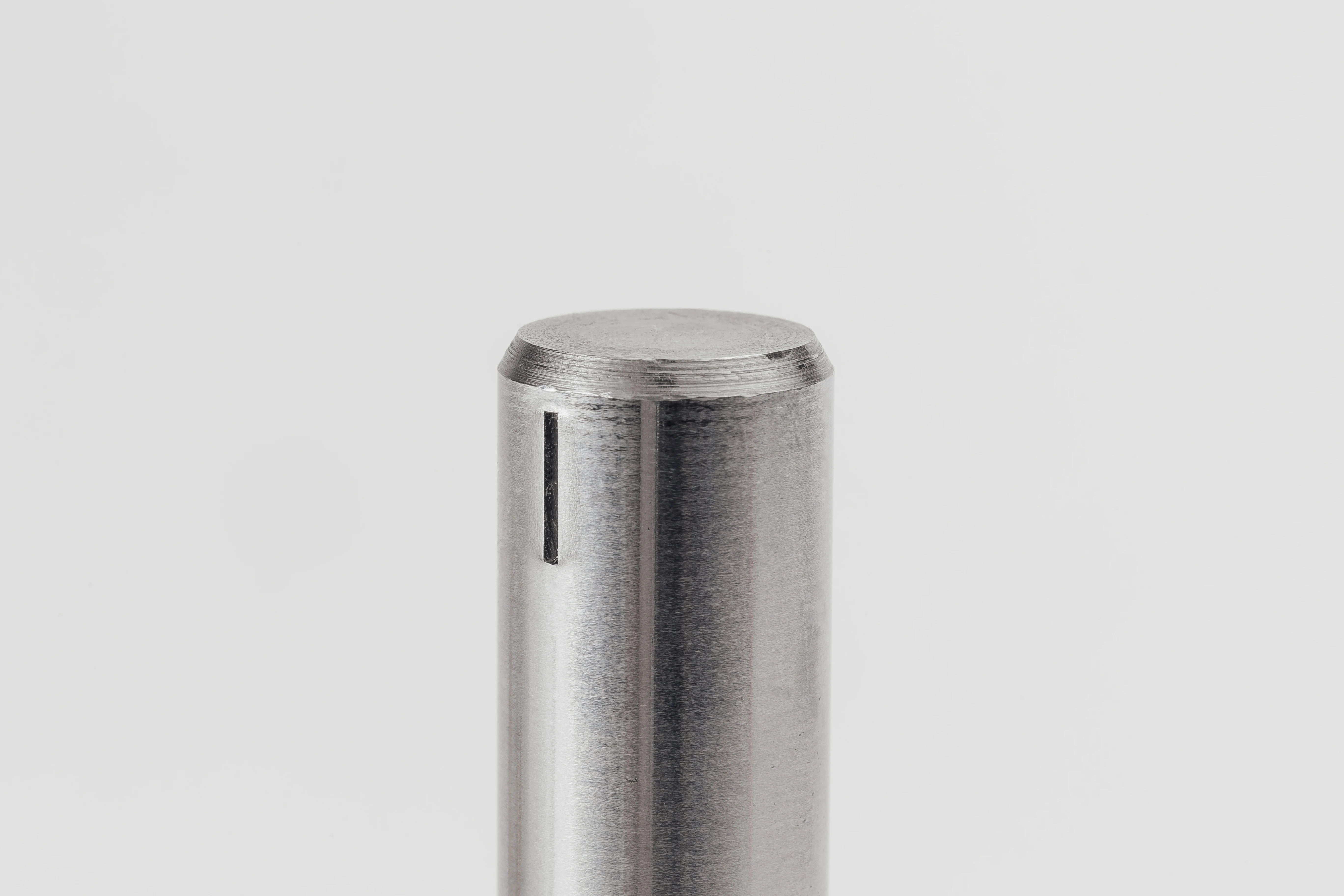2, rue de la Ternière
Avrillé cedex FRANCE
Pins with specific screw-cutting are cylindrical fasteners that have undergone a screw-cutting operation (action aimed at machining a part by removing material) in order to customize the geometric characteristics (flat grooves, turning, threads, branching, milling) according to customer requirements.
Thanks to the use of CAD and CNC machining and/or conventional lathes such as Escomatic, each turned pin is produced to precise dimensional tolerances, ensuring a perfect fit in the assembly. This process goes by many names, such as micro-machining, micro-turning, mechanical turning or precision turning. In any case, this process belongs to the family of mechanical machining and/or precision machining, the production of mechanical parts by turning, of reduced size with maximum precision.
Undercut pin - Cylindrical pin
What is a low-cut piece?
Machining by bar turning is a manufacturing technique that involves the removal of material to produce components. This method can be adapted to different materials such as steel, titanium, aluminum, brass and stainless steel, and can be found in all sectors of industry: mobility, household appliances, robotics, nuclear power, etc.
A turned part is the result of a process called décolletage, during which the part undergoes a "reworking" operation, involving the removal of material.
Bar turners like LGC use this technique, which dates back to the 18th century, and is frequently used to give precise geometric shapes to mass-produced parts. Turned parts can take on a variety of shapes, from the mundane to the highly complex.
Bar turning is often chosen because of its speed and efficiency in producing parts to exacting tolerances in large production runs. The bar turning process enables bar turners to combine precision machining with repeatability.
What is an undercut pin?
There are many different types of pins, all with different functions, including grooved pins, ground pins, smooth pins and undercut pins.
A pin with specific screw-cutting is a cylindrical pin or screw-cut metal shaft that has undergone a machining operation called screw-cutting. This precision machining operation is performed on a CNC or conventional lathe. The axle/pin is designed using CAD software by the design office. Eco-design is at the heart of the company's values, which translates, for example, into the optimization of the machining operation. Indeed, it is possible to reduce the quantity of material to be removed by choosing the right raw material and tools.
As a result, we can adjust the shape of the undercut pin to suit your project.
Contact us with your requirements, and we'll take care of the solution. Turned pins give you great flexibility in assembling your parts.
How are LGC precision-turned pins manufactured?
There are several steps involved in the manufacture of a specific undercut pin.
The first step is to understand the customer's needs, because understanding these needs is the first key to a project's success.
The second stage is the prototyping phase.
In fact, LGC is able to supply prototypes in order to distinguish between several solutions designed by the design office, or to test the final product in order to identify any discrepancies with the customer's requirements.
Once the solution has been validated, it's time for the industrialization phase, when the methods office determines the right tools for cutting the material, depending on the grade and shape required.
Initial samples are produced and tested in quantities ranging from 100 to 50,000 parts.
We check turned pins with our own instruments and high-quality control tools to be sure of the conformity of our parts. Important criteria include geometric dimensions: dimensions, tolerances, surface finish, bulge diameter, as well as mechanical characteristics: hardness, chemical composition, Young's modulus, crystalline structure, thickness and composition of the chemical coating. All these criteria are screened, and if they are declared compliant by both the quality department and the customer, the manufacturing process and the entire supply chain are validated.
Then it's on to the serial life of the low-cut pin.
The part is produced according to customer orders. Each production run is constantly monitored, enabling defects to be detected quickly and preventive or corrective action to be taken efficiently.
Before we dispatch the turned pins, we subject them once again to conformity checks carried out by our staff and high-tech machinery (three-dimensional laboratory, 100% inspection machine, digital profile projector). LGC strives for 0 PPM, a guarantee of quality for all cutting-edge industrial sectors.
What are the advantages of pins with special screw-cutting?
Metal pins are used in a wide range of industries: automotive, plastics, medical, household appliances.
There are different applications for different types of pins:
- Fixing pin
- Clamping pin
- Positioning pin.
The majority of our customers use this mechanical part in metallic environments, but the turned pin can be overmolded in injection-molded plastic. This material versatility ensures that the mechanical part is suitable for a wide range of applications, from the automotive industry to advanced electronics.
The specific undercut pin is a pin belonging to the cylindrical pin family, which enables several parts to be fastened, positioned and centered, offering considerable advantages:
- Greater precision: thanks to a specific screw-cutting process, it is possible to achieve greater dimensional accuracy for the pin, facilitating the assembly process and improving fastening precision.
- High strength: the contact surface created by the screw-cutting process between the pin and the workpiece optimally increases the shear strength of the screw-cut pin, ensuring durability over time.
- Less wear: parts are generally worn by their components. Thanks to the turned pin, there's less friction between the pin and the parts.
- Anti-corrosion: in corrosion-prone environments, bar turning can reduce pin corrosion by more than 50%, thanks to optimized shapes for fluid evacuation and lubricant distribution.
Our other pins
Our other spacers
Our other special parts
do the honors,
hover over the images!




